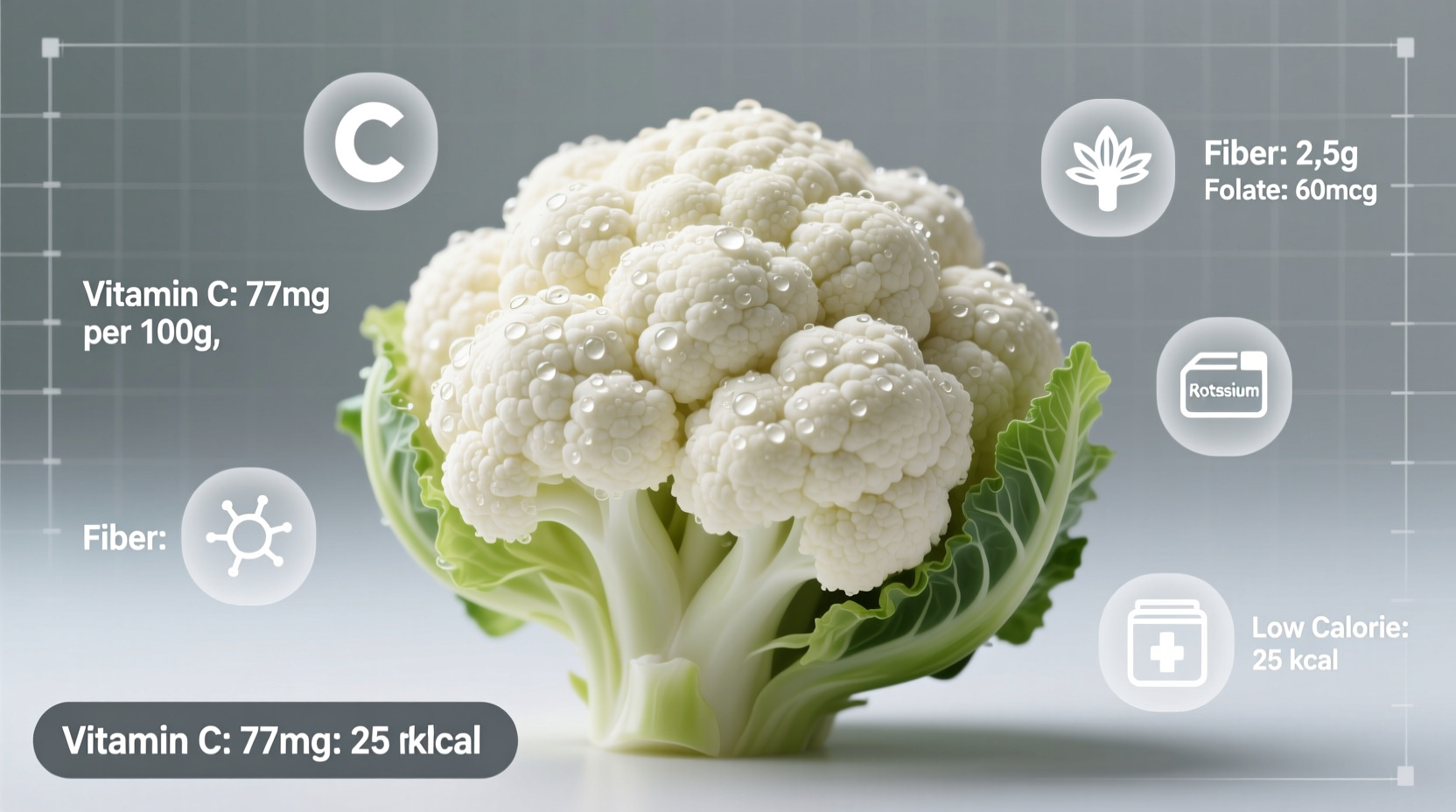Unlocking the Full Nutritional Power of Cauliflower
When you're looking for a nutritional powerhouse that doesn't break the calorie bank, cauliflower stands out among vegetables. This humble member of the Brassica oleracea family offers remarkable health benefits that extend far beyond its mild flavor and versatile culinary applications.
Complete Nutritional Profile: What's Inside One Head
Understanding cauliflower's nutritional composition helps you maximize its health benefits. According to the USDA FoodData Central database, a standard medium head of cauliflower (about 585g) provides:
| Nutrient | Per 100g (Raw) | % Daily Value* |
|---|---|---|
| Calories | 25 kcal | 1% |
| Protein | 1.9g | 4% |
| Total Carbohydrate | 5g | 2% |
| Dietary Fiber | 2g | 7% |
| Vitamin C | 48.2mg | 77% |
| Vitamin K | 15.5mcg | 13% |
| Folate | 57mcg | 14% |
| Vitamin B6 | 0.2mg | 10% |
| Potassium | 299mg | 6% |
*Percent Daily Values based on a 2,000 calorie diet. Source: USDA FoodData Central, release 17
Why Cauliflower Outperforms Many Vegetables
While all vegetables contribute to a healthy diet, cauliflower offers unique advantages. Unlike starchy vegetables such as potatoes or corn, cauliflower provides substantial nutrition with minimal calories. When comparing raw cauliflower nutrition facts to broccoli, both contain similar vitamin profiles, but cauliflower has slightly more pantothenic acid (vitamin B5) and less sugar.
The distinctive nutritional advantage comes from cauliflower's rich supply of glucosinolates—sulfur-containing compounds that transform into isothiocyanates like sulforaphane during chopping or chewing. According to research published in the Journal of Agricultural and Food Chemistry, these compounds demonstrate potent antioxidant and anti-inflammatory properties that support cellular health.

Maximizing Nutrient Retention: Preparation Matters
How you prepare cauliflower significantly impacts its nutritional value. Boiling causes the greatest nutrient loss, particularly for water-soluble vitamins like vitamin C and B vitamins. Research from the University of California, Davis shows that steaming cauliflower preserves up to 90% of its vitamin C content, compared to only 60% retention when boiled.
For maximum sulforaphane production—the compound with the most studied health benefits—follow this sequence:
- Chop or cut the cauliflower into florets
- Wait 40 minutes before cooking (allows enzyme myrosinase to activate)
- Steam gently for 3-5 minutes
This preparation method, recommended by the Linus Pauling Institute at Oregon State University, maximizes the formation of beneficial compounds while preserving nutritional integrity.
Health Benefits Backed by Science
The nutritional profile of cauliflower translates to several evidence-based health benefits:
Digestive Health Support
With 2 grams of fiber per 100g serving, cauliflower contributes to your daily fiber needs. The National Institutes of Health emphasizes that adequate fiber intake supports healthy gut microbiota and regular bowel function. The soluble fiber in cauliflower acts as a prebiotic, feeding beneficial gut bacteria.
Cellular Protection
Cauliflower's rich supply of antioxidants, particularly vitamin C and various phytochemicals, helps combat oxidative stress. A comprehensive review in Nutrients journal highlighted that cruciferous vegetables like cauliflower contain compounds that support the body's natural detoxification pathways at the cellular level.
Nutrient Density for Weight Management
For those monitoring calorie intake, cauliflower offers exceptional nutrient density. One cup of cauliflower rice contains approximately 25 calories compared to 200 calories in the same volume of cooked white rice. This makes it an excellent substitute in low calorie cauliflower recipes for weight management.
Practical Applications: Incorporating More Cauliflower
Understanding cauliflower nutrition is valuable, but applying this knowledge matters most. Here are practical ways to maximize its benefits:
- Raw consumption: Enjoy raw florets with hummus to preserve maximum vitamin C content
- Lightly cooked dishes: Try cauliflower mash as a lower-carb alternative to mashed potatoes
- Roasted perfection: Toss florets with olive oil and roast at 400°F for 20-25 minutes for enhanced flavor without significant nutrient loss
- Smoothie booster: Add raw cauliflower to fruit smoothies for extra nutrients without altering flavor significantly
Contextual Considerations: When Cauliflower Might Not Be Ideal
While cauliflower offers numerous benefits, certain situations warrant consideration. Individuals with irritable bowel syndrome (IBS) following a low-FODMAP diet may need to limit cauliflower consumption during elimination phases, as noted by Monash University's research on FODMAP content in foods.
Those taking blood-thinning medications should maintain consistent vitamin K intake. While cauliflower's vitamin K content (15.5mcg per 100g) is moderate compared to leafy greens, sudden changes in consumption could affect medication efficacy. The American Heart Association recommends discussing dietary changes with your healthcare provider if you're on anticoagulant therapy.
Storage Tips for Maximum Freshness and Nutrition
Proper storage preserves cauliflower's nutritional value. Keep whole heads in a perforated plastic bag in the refrigerator's crisper drawer for up to two weeks. Once cut, store florets in an airtight container with a slightly damp paper towel for 4-5 days. The USDA recommends against washing cauliflower before storage, as excess moisture accelerates spoilage.
Seasonal Availability and Nutritional Impact
Cauliflower is available year-round in most markets, but its peak season runs from October through March in the Northern Hemisphere. During peak season, locally grown cauliflower often shows slightly higher nutrient density according to agricultural studies from the University of California. Off-season cauliflower, typically shipped longer distances, may experience some nutrient degradation during transport.











 浙公网安备
33010002000092号
浙公网安备
33010002000092号 浙B2-20120091-4
浙B2-20120091-4